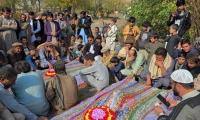LAHORE: The survival of Pakistan despite decades of corruption, incompetence and poor governance reflects its enormous natural and human resource potential. However, this resilience has reached its limits, and the country can no longer sustain itself under the burden of mismanagement.
The quality of life for most people has been progressively deteriorating. This decline is fuelled by an unfair taxation system where the burden falls disproportionately on the lower and middle classes while wealthy elites evade taxes. Life has become a luxury for the top 5.0 per cent of the population, while opportunities for the remaining majority are shrinking. Immediate reforms are essential, including good governance and stripping undue perks from the elite, comprising ruling politicians, bureaucrats and the judiciary.
Pakistan has been exploited by people with vested interests who, according to foreign reports, have parked their assets abroad. The undocumented economy now surpasses the size of the formal economy. While the country’s natural resources have been severely depleted, they can be restored within two to three years through better planning, transparency and effective governance.
Pakistan remains the ninth largest wheat producer globally. With certified seeds, equitable canal water distribution and improved agricultural extension services, the country could become a major wheat supplier. Similarly, while Pakistan is the fourth largest milk producer, its productivity lags behind due to inefficient practices requiring four times the number of milking animals compared to the US.
Rice exports continue to rise as Pakistan remains among the top 10 producers. However, the country has lost its position as a leading cotton producer, a gap that could be bridged with access to high-tech seeds and timely pest management. The once globally renowned integrated canal irrigation system has suffered from corruption and incompetence, necessitating transparent governance for its restoration. Furthermore, Pakistan’s vast rock salt deposits and the fourth largest coal reserves in the world remain underutilised.
While natural resources could recover within a few years, restoring human resource potential will take far longer. Pakistan boasts favourable demographics for growth, with over 63 per cent of its population under the age of 25. However, this youthful population requires access to quality education and healthcare to become a dependable workforce in the next decade.
Real progress depends on developing human capital, which can only bear fruit if nurtured today. A focus on natural resources and agriculture could bring short-term prosperity, but the nation’s future hinges on empowering its human resources.
The current government has taken difficult yet necessary decisions, which have faced resistance from the business community but are beginning to yield results. Exports, particularly in the textile sector, are rising, despite challenges in certain sub-sectors. The banking sector has remained resilient, and macroeconomic indicators are gradually improving.
Strengthening and sustaining these reforms is essential to securing a brighter future for the next generation. While challenges remain, Pakistan has the potential to turn its fortunes around with sincerity, transparency and collective effort.
A representational image of the expo centre. —Facebook@PakistanExpoCentres/FileLAHORE: The Trade Development...
People wearing Omega watches can be seen. —Facebook@SonrajOfficial/FileKARACHI: Sonraj, a leading name in the...
Samsung logo can be seen. — Reuters/FileKARACHI: Sapphire Electronics Limited, a subsidiary of Reliance Cotton...
Image showing a view of Doha Forum. — X@DohaForum/FileThe Doha Forum, held from December 7-8, 2024, once again...
Electric power generating wind turbines and solar panels can be seen. — AFP/FileLAHORE: Global efforts to bolster...
A model of the natural gas pipeline is placed on Russian Rouble banknote and a flag in this illustration taken, March...







